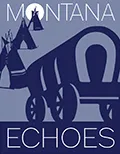From 1869 to about 1885, Kelly served the U.S. Army earning the nickname, “Yellowstone Kelly.” During one mission, Kelly was ambushed by two Sioux warriors. Though wounded, Kelly managed to kill the two assailants. During the skirmish, Kelly took an arrow to the knee and lost the tip of his right little finger (the stub of which can be seen in many photographs of Kelly) to an Indian’s musket ball.
Between 1870 and 1880 the Indian Wars were intensifying. During this time Kelly roamed Montana’s Judith Basin where he became renowned as a large game hunter and scout.
When the news of the Little Big Horn Battle reached Kelly, he rejoined the U.S. Army serving as Chief of Scouts under Brig. Gen. Nelson Appleton Miles. Kelly remained in the army until the suppression of the Sioux and the surrender of Crazy Horse.
In the spring of 1898, Kelly accompanied Captain Edwin F. Glenn to Alaska where he served as an interpreter and guide. Soon after arriving, news of the outbreak of the Spanish-American War reached the expedition. Kelly was offered a commission as a captain and departed Alaska in October 1898. The war ended by the time Kelly arrived in Seattle.
Less than a year later, the U.S. Congress authorized the U.S. Army to put down an insurgency in the Philippines. Kelly received another commission as captain and left Fort Riley, Kansas in November 1899 to travel to California where he would join Brig. General James Bell and board a vessel to Manila.
Kelly’s company came under attack outside the town of LaLud by insurgents under the command of Colonel Legaspi. His men returned fire, killing the insurgent artillerymen. Kelly led a frontal assault and successfully crushed the attack, capturing Legaspi’s ceremonial Spanish sword in the process.
Later, Kelly served in the administration of the new civilian governor of the Philippines, future U.S. President Willam H. Taft. Three years after arriving in the Philippines, Kelly traveled back to Washington D.C. before being assigned as the Indian Agent for the San Carols Indian Reservation in Arizona.
In 1915, Kelly settled permanently in Paradise, California where he died on December 17, 1928. Luther Sage “Yellowstone” Kelly was buried on a high bluff above the Yellowstone River Valley in Billings, Montana with the sword he captured from Legaspi at LaLud. He wrote, “I feel my body will rest better in Montana, the scene of my earlier activities, than it would in the vastness of Arlington, where I purposed having it laid.”






